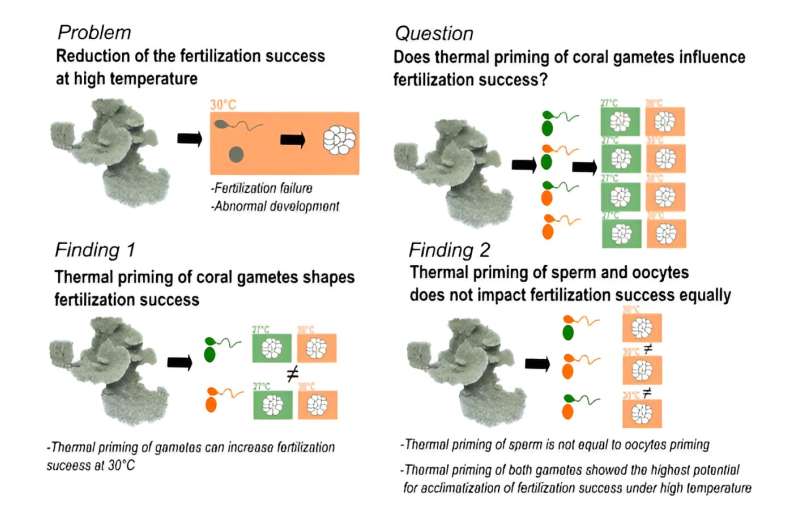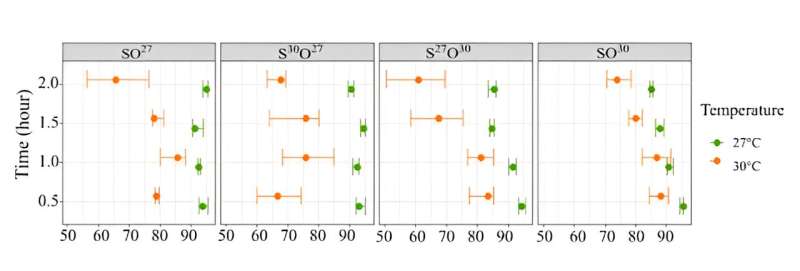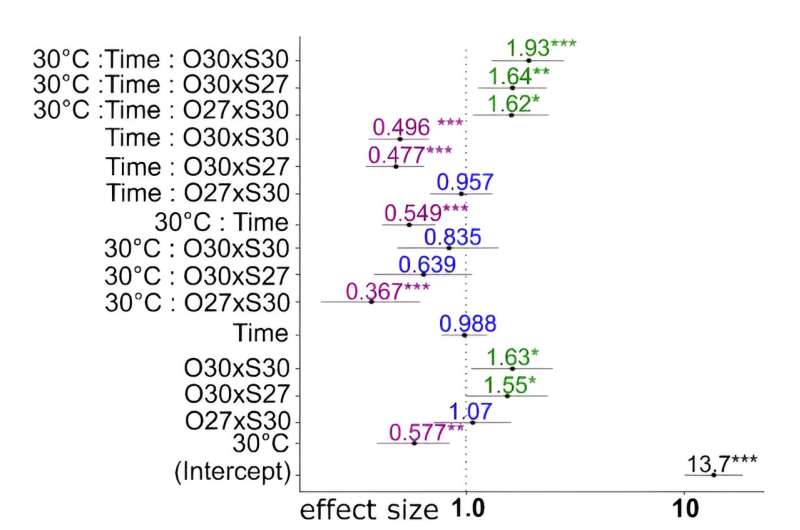September 5, 2023 feature
This article has been reviewed according to Science X's editorial process and policies. Editors have highlighted the following attributes while ensuring the content's credibility:
fact-checked
peer-reviewed publication
trusted source
proofread
How might coral adapt to rising ocean temperatures? Thermal priming of gametes could hold promise

As seawater temperatures rise, concern over the ability of coral to survive and reproduce also grows. Previous studies have largely focused on the effects of acclimating adult corals to warming temperatures via thermal priming, and have yielded varying results.
Now, an international research team has tested the effect of thermal priming on coral gametes. Their study has been published in the Journal of Experimental Marine Biology and Ecology.
Within the ecology of the ocean, healthy corals sustain many other species, help protect coastlines by tempering the power of waves, and are crucial to the success of industries such as fishing and tourism. But when water temperatures become too warm, corals may respond by bleaching, during which they excrete the symbiotic algae that serve them as an important food source and provide their color. Though corals can survive bleaching events, they may emerge with weakened systems, and prolonged ocean heat waves can be fatal to corals.
According to the Coral Reef Alliance, corals generally do well at ocean temperatures between 23°C and 29°C. But a 2018 climate change forecast from the Intergovernmental Panel on Climate Change (IPCC) asserts that a temperature increase of 2°C by the middle of the 21st century could have globally devastating consequences for coral reefs.
During the adult phase of their life cycle, corals may reproduce by differing methods; either by asexual fragmentation or by sexual fertilization between oocytes and sperm, during a period spent at the bottom of the ocean (benthic phase). Most sexually reproducing corals are hermaphroditic, and spawn both oocytes and sperm to be fertilized externally. After fertilization occurs, the larvae of brooding corals settle right away, while the larvae of broadcast spawning corals may spend weeks in an open-water (pelagic) development phase before they settle.
Existing studies show that thermal priming (periods of exposure to higher water temperatures) of some species of adult corals during their brooding phases has yielded positive responses from the resulting larvae. However, it was not known whether similar tests on coral gametes would show positive effects, nor whether such effects would carry to subsequent life stages.
In this study, the researchers focused on the coral species Acropora cytherea, a broadcast spawner, in French Polynesia, where ocean temperatures currently average between 26°C and 28°C. The team hypothesized that male and female coral gametes exposed to water temperature variations before fertilization would exhibit differing fertilization outcomes.

Using freshly spawned oocytes (O) and sperm (S) collected from seven gravid coral colonies off the coast of Mo'orea, the research team exposed them separately to temperatures of 27°C or 30°C for durations of 0.5, 1.0, 1.5, or 2.0 hours before any fertilization occurred, limiting to two hours the time between spawning and fertilization. Immediately after this thermal priming, the researchers began fertilization trials at the same two temperatures using four combinations of oocytes and sperm that had been separately primed at different temperatures (with number indicating temperature): S27O27, S30O27, S27O30, and S30O30.
The team found that results varied according to combinations of the three conditions of gamete exposure duration, exposure temperature, and fertilization temperature. Therefore, fertilization success could not be attributed to any one of these factors on its own.

At a priming temperature of 30°C, exposure duration of both sperm and oocytes affected fertilization success in different ways. Notably, oocytes thermally primed at 30°C before fertilization more strongly moderated the overall negative effect of a 30°C water temperature on fertilization than did sperm primed at 30°C. The specific thermal priming periods of 0.5 and 1.0 hour at 30°C were also found to maximize the chance for successful fertilization of this coral species in this context.
However, the research cautions that further testing is needed for other factors, such as a genetic selection mechanism for gamete mating performance and environmental effects encountered by gametes before any thermal exposure. Enduring coral gamete biology effects could affect coral's subsequent life stages. All new knowledge of gametes must be considered and understood along with what is already known about the other life stages if coral is to adapt to and thrive in rising ocean temperatures.
More information: Antoine Puisay et al, How thermal priming of coral gametes shapes fertilization success, Journal of Experimental Marine Biology and Ecology (2023). DOI: 10.1016/j.jembe.2023.151920. On arXiv: DOI: 10.48550/arXiv.2308.14373
Journal information: Journal of Experimental Marine Biology and Ecology , arXiv
© 2023 Science X Network


















